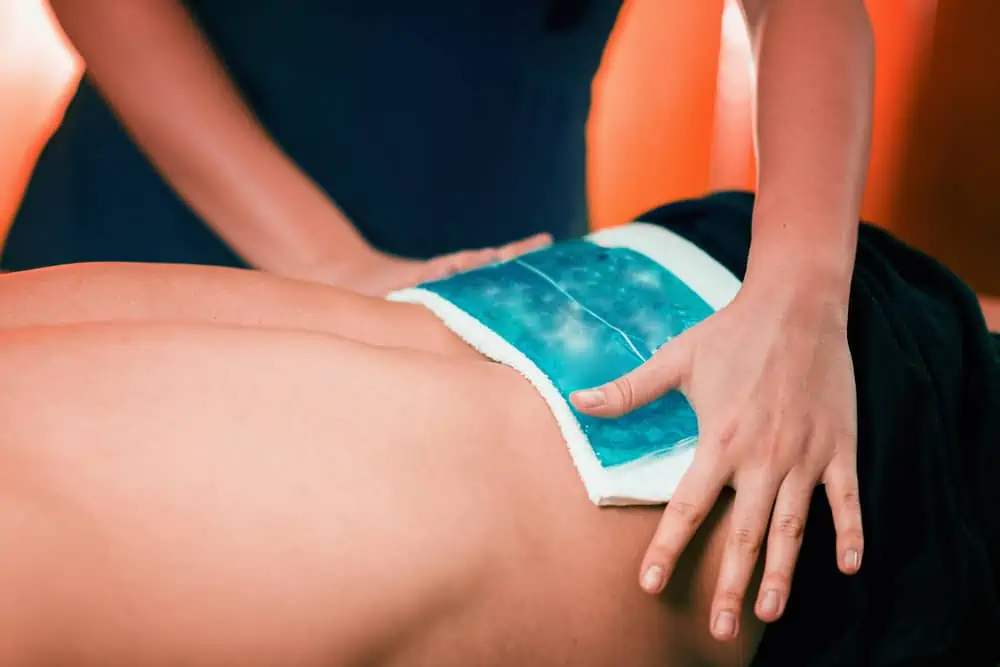This post may contain affiliate links. If you click through a link and make a purchase, I may receive a commission at no additional cost to you. As an Amazon Associate, I earn from qualifying purchases. Read the full disclosure here.
Standing desks are trending in popularity over the past few years as people look for new ways to increase activity and decrease prolonged sitting adverse effects.
In 2020, more things than ever have moved online. While this is convenient, it also means a ton more sitting glued to technology.
But how do you know if a standing desk is right for you? And is it truly better than your traditional “sitting desk”?
You’ve probably heard this catchphrase circulating: “Sitting is the new smoking.”
That seems dramatic.
Let’s unpack this phrase a little more. As usual, the devil’s in the details, so keep reading for all the standing desk pros and cons you need to make the right decision for you.
Disclaimer: This content is for educational purposes and is not medical advice. Read the full disclaimer.
Health risks of prolonged sitting
Humans were made to move. Everything from heart function to digestion requires movement and circulation to work optimally. Stagnant is no good.
Too much sitting has been linked with many health issues such as:
- Muscle weakness
- Pain and stiffness
- Weight gain
- Heart disease
- Diabetes
- Adverse effects on mental health
- Higher risk of DVTs
Sitting is not inherently bad, rather it’s how much time is spent sitting over the course of every day. Of course, these risks are worse if you lead a sedentary life in general and make unhealthy choices.
Context matters.
There’s a difference between sitting for work and sitting all day every day with no attempts to be active.
Still, people are on the hunt to find ways to improve their health.

Standing desk pros and cons
Standing desks (aka stand up desk or sit stand desk) are becoming more popular in our effort to decrease sedentary behavior, yet still manage to chain ourselves to a desk.
There are pros and cons to any workstation set up.
Let’s take a look at both sides of the equation to help you decide if a standing desk is right for you.
Benefits of standing desks
Research on standing desks is still in its early stages, however, there are some standing desk pros.
So far, it’s thought that standing desks may lower the risk of heart disease and diabetes. Using a standing workstation may help reduce low back pain (a primary complaint of prolonged sitting) and boost mood/productivity.
Time will tell.
When standing, you’re also able to weight shift and pace around. If you like to fidget, a standing desk might be up your alley.
An electric standing desk makes it easy to switch between sitting and standing positions with the push of a button.
Do standing desks burn more calories?
Some claims are circulating that standing burns more calories.
While no one argues with the promise of “burning more calories,” don’t be tricked into the idea that by simply standing, you’re getting exercise.
Creasy et al. Compared energy expenditure with sitting, standing, and walking.
The study found that substituting periods of walking significantly increased energy expenditure. Replacing standing for sitting had little to no effect.
The bottom line, you’ll burn more calories walking to the bathroom. Don’t rely solely on a standing desk to address health problems or weight loss goals.
Disadvantages of standing desks
But are standing desks better? Long hours in a standing position sounds like swapping one problem for another. Let’s clear up a few misconceptions.
Simply “standing” is not exercise, nor does it guarantee good posture. Prolonged standing can take its toll on your health too.
Ask anyone whose job requires standing for long hours. All they want to do at the end of the day is sit down!
Too much standing can cause:
- Sore feet/ankles
- Plantar fasciitis
- Swelling
- Varicose veins/stress on circulation
- Low back pain
- Joint pain
- Muscle fatigue
Standing still for more than 4 hours at a time is likely to increase these risks.
There also isn’t a lot of scientific proof at this time. It’s assumed that there are benefits to standing because you’re “not sitting.”
Standing desks are only beneficial if they can be adjusted to suit your height. This is where an adjustable standing desk comes into play. If your desk is too short or too high, the potential postural benefits no longer exist as you attempt to compensate for poor ergonomics.
Standing desks can be pricey, but worth it if you decide this option works well for you.
Standing desks also don’t help things like workload stress, eye strain, or toxic environments, which play a role in your overall health and wellbeing. Standing also does not automatically fix bad posture.
If you have any injuries or medical conditions that affect your ability to stand for long periods, then a standing desk is not for you.
A standing desk alone is not going to fix an unhealthy lifestyle.
Related read: How To Stop Slouching At Your Desk

How long should you stand at a desk?
Moderation wins again.
The best option is to have a way to move through sitting and standing at regular intervals every hour.
The recommended ratio of standing to sitting should be between 1:1 and 3:1. Ideally, you should aim to stand at least as much as you sit, if not more.
The best type of set-up to accomplish this would be an adjustable desk. This option combines the benefits of a traditional desk with a standing workstation.
The major health benefit is being able to quickly shift between standing and sitting to ease aches and pains and decrease the number of hours spent sitting each day.
Electric desks make this switch effortless. There are also some less expensive manual options. Pro tip: make sure your cables and cords are long enough to handle the height difference!
Here’s an affordable desktop option that’s great for a home office standing solution. You can also buy smaller accessories to transition an existing desk into a standing option.
Stand Desk Inc. also has adjustable standing desks with on-trend wood tops to match your decor.
Standing desk ergonomics
It’s still possible to still have poor ergonomics at a sit stand workstation.
The standing desk has to be adjusted to you to avoid postural muscle strain. This might be a problem at a shared workstation if you’re very tall or very short. Do what you can to adjust monitor angles and the height of the desk if possible.
If you work on a laptop, you’re still at a disadvantage by needing to always look down. Good ergonomic setups for standing desks are better achieved with a desktop monitor adjusted for height.
Check out this article from Mayo Clinic for optimal set up of your standing desk or watch the quick video below.
Do anti-fatigue mats help?
One of the best accessories for a standing desk is an anti-fatigue mat.
A standing mat is slightly squishy and encourages weight shifting and movement to aid blood flow and fluid return.
You may have noticed large black rubber mats in commercial kitchens or behind registers of supermarkets. These specialized surfaces can help reduce feelings of pain and tiredness in the legs for prolonged standing.
Check out some of these other workstation accessories to improve your ergonomics and make desk life a little more manageable.

How to stay active at work
Whether you’re standing or sitting, taking breaks has both physical and mental benefits.
Here are some ideas to give your mind and body a break during the workday.
Set a timer
Set a timer to remind you to get up every 30-45 min. Not only is this a much-needed physical break, but a mental break as well.
Get a change of scenery even if it’s looking out the window. This helps with other issues like eye strain.
Wear a smartwatch or fitness tracker
Many fitness trackers and smartwatches have built-in functions to remind you to stand, which you can set to your personal frequency. This is a convenient way to add more physical activity to your regular routine.
Get a tap on the wrist when it’s time and get up!
Read The Ultimate Guide to Fitness Trackers for all the details and science behind fitness watches to help you decide which is right for you.
Try a theraball chair
You would not want to sit on this type of office chair all day long, but sitting on a ball intermittently is another way to weave some movement into your day.
It might also wake you up if your work is a real snooze.
Check out this office theraball chair.
Remember, focusing on your posture and taking breaks is still important.
A fancy desk chair will only help so much.
Keep filling your water bottle
Hydration is vital for health.
Keep a water bottle near you and stay hydrated. Not only will you need to refill the bottle periodically, but you’ll also likely need to take more bathroom breaks, which is another way to get you up and moving.
Take lunchtime walks
Lunchtime walks are a great stress reliever and a way to break free from your work.
Walking at a moderate pace counts toward your movement goals for the week to maintain an active lifestyle.
Taking a movement break from work can also help you be more productive. How many times has the answer come to you while you were randomly doing other things?
Take the stairs
If your work has stairs, weave a few flights in even if you don’t need to.
Climbing stairs is a great way to get your heart rate up quickly and boost your activity.
Have a goal such as climb ten flights by the end of the day.
Try chair yoga poses
Take your practice off the mat. Here are three chair yoga poses to do at your desk.
(Those super cool striped leggings are K-Deer, for my fashionistas who just need to know! – and yes, you should definitely check them out!)
Seated twist

How to perform
- Sit upright in your chair
- Rotate as far as you can comfortably to one side and take 3-5 deep breaths
- Repeat on the opposite side
Seated pigeon (seated figure 4 stretch)

How to perform
- Cross one ankle over the opposite knee
- Keep the foot flexed to protect the knee joint
- Lean your chest forward to deepen the stretch
- Hold for 20-30 seconds taking slow deep breaths
Seated thoracic extension

How to perform
- Clasp your hands behind your head
- Think of pulling yourself up and arching the upper back simultaneously; let the head follow where it’s comfortable.
- Return to neutral
- Repeat 5-10 times
Foam rolling
Foam roller exercises are another way to ease pain from poor posture at your desk.
Read The Best 7 Foam Roller Exercises To Combat Poor Desk Posture for a full how-to of the best areas for office workers to foam roll.
Grab an extra foam roller to keep by your desk. The compact size of the Trigger Point Grid roller is one of my favorites.
Get regular exercise
The problem isn’t sitting. It’s leading a sedentary lifestyle.
For overall health benefits, aim for at least 150 min of moderate aerobic activity each week.
Regular exercise is the closest thing to magic to reduce all-cause mortality. And no, standing at your desk does not count toward this goal. #sorrynotsorry
Read 4 Secrets to a Well-Rounded Fitness Routine to learn how to build a program for overall health benefits.
Here are a few movement practices from my YouTube channel targeting areas that get stiff during the workday.
Are standing desks overrated?
The best workstation setup is going to be the one that works for you. There are many standing desk pros and cons to consider.
Both too much standing and excessive sitting come with their respective risks, especially when coupled with poor health choices. Standing and ergonomic desks will not fix an unhealthy lifestyle.
Standing desks offer a unique new way to tackle the same old job. If it works for you, go for it! A height adjustable desk is best to ensure proper standing posture without compensations.
The best standing desk offers the option to switch between sitting and standing throughout the day for comfort. But don’t be tricked into thinking that by simply standing, you’re getting exercise.
If you’re a generally active person and make efforts to take breaks and move, sitting for work shouldn’t be a problem.
If a standing desk is not in your budget (or not on offer from your employer), there’s still plenty of ways to mitigate the health risks of too much sitting.
Whichever you choose, just remember to move more!
(And no, sitting is not the new smoking – in case you didn’t get the memo!)
featured image credit: depositphotos.com
References
Owen N, Healy GN, Matthews CE, Dunstan DW. Too much sitting: the population health science of sedentary behavior. Exerc Sport Sci Rev. 2010;38(3):105-113. doi:10.1097/JES.0b013e3181e373a2
Biddle SJ, Bennie JA, Bauman AE, et al. Too much sitting and all-cause mortality: is there a causal link?. BMC Public Health. 2016;16:635. Published 2016 Jul 26. doi:10.1186/s12889-016-3307-3
Finch LE, Tomiyama AJ, Ward A. Taking a Stand: The Effects of Standing Desks on Task Performance and Engagement. Int J Environ Res Public Health. 2017;14(8):939. Published 2017 Aug 21. doi:10.3390/ijerph14080939
Creasy SA, Rogers RJ, Byard TD, Kowalsky RJ, Jakicic JM. Energy Expenditure During Acute Periods of Sitting, Standing, and Walking. J Phys Act Health. 2016 Jun;13(6):573-8. doi: 10.1123/jpah.2015-0419. Epub 2015 Dec 21. PMID: 26693809.
Møller SV, Hannerz H, Hansen AM, Burr H, Holtermann A. Multi-wave cohort study of sedentary work and risk of ischemic heart disease. Scand J Work Environ Health. 2016 Jan;42(1):43-51. doi: 10.5271/sjweh.3540. Epub 2015 Dec 9. PMID: 26649851.








I have both a regular desk and a standing desk at my job, but I tend to alternate between the two. For me, I prefer to just keep moving as much as possible, so I’m not in the same position for too long. That is my goal. So I also build in little ways to move more while working – choosing to go to the farthest bathroom, or the farthest copy machine. I try to take breaks to do a mile walk several times a day. The standing desk option is nice to have, but I’m glad to still be able to use a regular desk.
Thanks for the great information! This helps because I have a standing desk but often forget to use it. I love the stretches too and plan to use them!
Thank you!
I think need one. I always get back pains from sitting all day.
Let us know how it goes!
This is really great information! I have noticed that when I stand during the day, it makes my back hurt and my feet tired. I like your idea of taking frequent breaks to stand up and move if you sit throughout the day. Thank you for the awesome post!
Thanks, I hope the information helps you!
I’ve benefited a lot from a standing desk, especially during the lockdown. Standing can make you feel tired at some point, but a good balance between sitting and standing is the key in my opinion.
Thank you for reading!
Love the variety of tips here. There isn’t one way to stay active at work.
Thank you!
Great article. It’s important to pick a good standing desk. I feel mine is so wobbly I am almost scared I am going to lose my computer so I don’t use it as much as I should.
I hope you find a standing desk that works well for you soon. Thanks for reading!
I actully have a larger, automated sit/stand in my office at my 9-5 job, and I love it! I’m able to program heights, and adjust height however I’d like throughout the day. The whole L-shape goes up and down, which is so beneficial! I just had a regular desk before this one, and I don’t think I’ll ever go back.
Glad it’s working for you. Thanks for reading!
We were supposed to get desks that we can move up and down before the pandemic. I would have loved it, especially after lunch; I always have a down around 1-2 pm where I just want to go take a nap. A standing desk would help! But I agree, I worked in stores and standing up all day is torture ?
Yes, a good balance of standing and sitting is the best. Hopefully, you’ll still get those desks. Thanks for reading!
I’m hoping to get an adjustable desk in my office, so I’ll have more ability to move around. Also, I love the stretches that you mention! Stretching is so critical and helps way more than people think. Thank you for sharing your insight! 🙂
Thanks for reading!